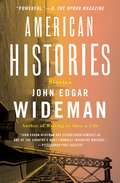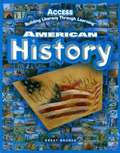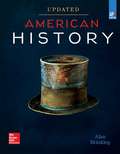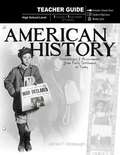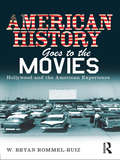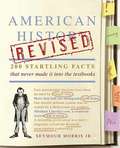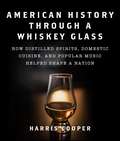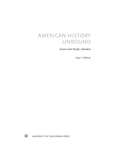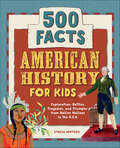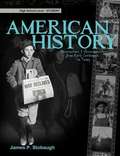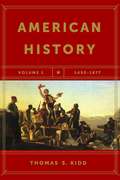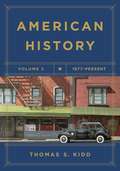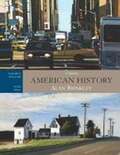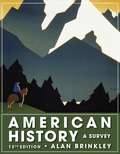- Table View
- List View
American Histories: Stories
by John Edgar WidemanIn this singular collection, John Edgar Wideman, the acclaimed author of Writing to Save a Life, blends the personal, historical, and political to invent complex, charged stories about love, death, struggle, and what we owe each other. With characters ranging from everyday Americans to Jean-Michel Basquiat to Nat Turner, American Histories is a journey through time, experience, and the soul of our country. <P><P>“JB & FD” reimagines conversations between John Brown, the antislavery crusader who famously raided Harper’s Ferry, Virginia, and Frederick Douglass, the abolitionist and orator, conversations that belie the myth of race and produce a fantastical, ethically rich correspondence that spans years and ideologies. “Maps and Ledgers” eavesdrops on a brother and sister today as they ponder their father’s killing of another man. <P><P>“Williamsburg Bridge” sits inside a man sitting on a bridge who contemplates his life before he decides to jump. “My Dead” is a story about how the already-departed demand more time, more space in the lives of those who survive them. <P><P>Navigating an extraordinary range of subject and tone, Wideman challenges the boundaries of traditional forms, and delivers unforgettable, immersive narratives that touch the very core of what it means to be alive. <P><P>An extended meditation on family, history, and loss, American Histories weaves together historical fact, philosophical wisdom, and deeply personal vignettes. More than the sum of its parts, this is Wideman at his best—emotionally precise and intellectually stimulating—an extraordinary collection by a master.
American History
by Robert Dallek Donna M. Ogle Jesus Garcia C. Frederick RisingerNIMAC-sourced textbook
American History
by Robert Dallek Donna M. Ogle Jesus Garcia Frederick RisingerAmerican History uses four key strategies to help students become successful history readers and more knowledgeable about the state's standard. These strategies are: set a purpose for reading, build your social studies vocabulary, use active reading strategies and check your understanding.
American History
by Dr Ames West Davidson Dr Michael B. Stoff Dr Kathy Swan Jennifer L. BertoletNIMAC-sourced textbook
American History
by John Shefelbine Elva Duran Jo Gusman Great Source Education Group StaffAn American history textbook covering periods from European colonization to the 21st century.
American History (AP US History Series)
by Alan Brinkley"[The] perfect guide to the latest version of AP United States History curriculum. The new AP Edition ... fully addresses the revised AP U.S. History Curriculum and provides students with the guidance and support they need to master the key concepts, themes, historical thinking skills, and the new AP US History Exam"--Back cover.
American History (New York Edition)
by Robert Dallek Donna M. Ogle Jesus Garcia C. Frederick RisingerAmerican History uses four key strategies to help one become a more successful reader of history, and more knowledgeable about their state's standards. These strategies are: set a purpose for reading, build your social studies vocabulary, use active reading strategies and check your understanding
American History - Teacher Guide
by James P. StobaughThis convenient teacher's guide is all a parent or teacher needs to easily grade the 10th grade student assignments for American History: Observations & Assessments from Early Settlement to Today. Assignments with answers, learning objectives, grading criteria, and short essay questions are included. This course is designed for a student to practice independent learning. The guide will assist teachers by offering: 34 chapters for 34 weeks of study Chapters include 5 lessons taking approximately 30 minutes each The final lesson of the week is an exam covering the week's instruction Student questions are organized in the back for easy use in testing and review Teachers, parents, or students can grade assignments daily or weekly As the teacher, you will enjoy partnering with your student as he or she processes American history while developing or strengthening a Christian world view.
American History Goes to the Movies: Hollywood and the American Experience
by W. Bryan Rommel RuizWhether they prefer blockbusters, historical dramas, or documentaries, people learn much of what they know about history from the movies. In American History Goes to the Movies, W. Bryan Rommel-Ruiz shows how popular representations of historic events shape the way audiences understand the history of the United States, including American representations of race and gender, and stories of immigration, especially the familiar narrative of the American Dream. Using films from many different genres, American History Goes to the Movies draws together movies that depict the Civil War, the Wild West, the assassination of JFK, and the events of 9/11, from The Birth of a Nation and Gone with the Wind to The Exorcist and United 93, to show how viewers use movies to make sense of the past, addressing not only how we render history for popular enjoyment, but also how Hollywood’s renderings of America influence the way Americans see themselves and how they make sense of the world.
American History Revised: 200 Startling Facts That Never Made It into the Textbooks
by Seymour Morris Jr.This spirited reexamination of American history (1776-2000) digs deep into our past to expose 200 startling facts that never made it into the textbooks, and highlights how little-known individuals and events played surprisingly influential roles in the great American story. We tend to think of history as settled, set in stone, but American History Revised is filled with evidence that American history is filled with ironies, surprises, and misconceptions. As author Seymour Morris, Jr. colorfully illustrates through the 200 historical vignettes that make up this book, much of our nation's past is quite different - and far more remarkable -- than we thought. Here we learn that in 1932, the U.S. Navy staged a mock attack on Pearl Harbor that resulted in the conclusion that the entire fleet of ships and planes stationed there were vulnerable to being wiped out on a Sunday morning. The Navy swore such an event could never happen and then forgot about it. The Japanese, however, noticed. And on December 7th, 1941, they copied the military exercise exactly. We also discover that: * America's largest corporation has never appeared on a Fortune 500 list * The two generals who ended the Civil War weren't Grant and Lee * The #1 best-selling American book of all time was written in one day * The Dutch made a bad investment buying Manhattan for $24 * Two young girls aimed someday to become First Lady - and succeeded * Three private financiers saved the U.S. from bankruptcy. Organized into ten thematic chapters, American History Revised plumbs American history's numerous inconsistencies, twists and turns to make it come alive again. Written in a lucid, often puckish style and backed by serious scholarship, extensive footnotes, and 50 illustrations, this book will leave readers astonished and entertained.
American History Since 1865-Student Pages-Semesters 2
by K12 Inc.Study guides, worksheets and assessment for students to take them through the American History since 1865.
American History Stories...Volume I: The Shot Heard 'Round the World
by Mara L. PrattThis is the story of the American Revolution as you have never read it before. Volume One is a photo-reproduction of an original history book used in 1889 to teach our children the grandeur of the America vision. These pages contain the stories of countless men, women and children who pledged their lives, liberty and sacred honor to the grand experiment in freedom; a revolution that would change the world forever.
American History Through a Whiskey Glass: How Distilled Spirits, Domestic Cuisine, and Popular Music Helped Shape a Nation
by Harris CooperExperience American history like never before with this unique, informative, and fun guide for history buffs, whiskey enthusiasts, folks who like to cook at home, and fans of popular music.American History Through a Whiskey Glass presents a unique perspective on American history. It describes how bourbon and rye whiskey played a role in the most important events in American history, including the voyage of the Mayflower, George Washington&’s failed and successful political campaigns, the Civil War, pioneers moving west, Prohibition (of course), plus many more into the twenty-first century. It does so with descriptions of historical events but also with amusing anecdotes and humorous quotes from the historical figures themselves. The book carefully aligns five elements: a narrative about whiskey&’s role in eight periods of American historydescriptions and tasting notes for American whiskeys that represent distilled spirits in each historical periodtutorials on how whiskey is produced and its numerous varietiesperiod-specific food recipes drawn mostly from historical cookbooksplaylists of the popular music during each period The book gives readers an integrated and entertaining perspective on popular culture in America at different times, revealing how Americans have politicked, drank their native spirits, ate, and sang. But it does more; readers will not only learn about America&’s history, they can experience it through numerous illustrations, whiskey tasting, food, and music. It provides an opportunity for readers to be involved in a truly immersive approach to life-long learning . . . and it&’s fun.
American History Unbound
by Gary OkihiroA survey of U.S. history from its beginnings to the present, American History Unbound reveals our past through the lens of Asian American and Pacific Islander history. In so doing, it is a work of both history and anti-history, a narrative that fundamentally transforms and deepens our understanding of the United States. This text is accessible and filled with engaging stories and themes that draw attention to key theoretical and historical interpretations. Gary Y. Okihiro positions Asians and Pacific Islanders within a larger history of people of color in the United States and places the United States in the context of world history and oceanic worlds.
American History for Kids: Exploration, Battles, Tragedies, and Triumphs—from Native Nations to the U.S.A. (500 Facts)
by Stacia DeutschInteresting facts that teach kids ages 8 to 12 about American historyKids don't need long, boring textbooks to learn about history. Starting with America's earliest inhabitants in 20,000 BCE and finishing in the modern day, American History for Kids helps them explore America's past through memorable and exciting facts that they will love to share.This engaging look at American history for kids age 8-12 includes:500 facts—This book introduces kids to many of the incredible things that have happened in America, one informative tidbit at a time.The complete timeline—Kids will learn all about important people, places, and events across thousands of years of American history.A leg up on learning—These facts provide kids with a head start on the topics they'll be covering in class, plus things they might not learn in school.Help history come alive with the incredible facts inside this top choice among American history books.
American History-Student
by James P. StobaughRespected Christian educator, Dr. James Stobaugh, offers an entire year of high school American history curriculum in an easy to teach and comprehensive volume. American History: Observations & Assessments from Early Settlement to Today employs clear objectives and challenging assignments for the tenth grade student. From before the birth of our republic to the principles of liberty, American history trends, philosophies, and events are thoroughly explored. The following components are covered for the student: Critical thinking Examinations of historical theories, terms, and concepts History makers who changed the course of America Overviews and insights into world views. Students will complete this course knowing the Christian influences that created a beacon of hope and opportunity that still draws millions to the United States of America. This 384-page student resource should be used in conjunction with the American History: Observations & Assessments from Early Settlement to Today for the Teacher. British History and World History are included in this comprehensive high school history curriculum for 10th, 11th, and 12th grades offered by Dr. James Stobaugh and Master Books.
American History: 1492 - 1877
by Thomas KiddAmerican History volume 1 surveys the broad sweep of American history from the first Native American societies to the end of the Reconstruction period, following the Civil War. Drawing on a deep range of research and years of classroom teaching experience, Thomas S. Kidd offers students an engaging overview of the first half of American history. The volume features illuminating stories of people from well-known presidents and generals, to lesser-known men and women who struggled under slavery and other forms of oppression to make their place in American life. The role of Christianity in America is central in this book. Americans’ faith sometimes inspired awakenings and the search for an equitable society, but at other times it justified violence and inequality. Students will come away from American History volume 1 better prepared to grapple with the challenges presented by the history of America’s founding, the problem of slavery, and our nation’s political tradition.
American History: 1877 - Present
by Thomas KiddAmerican History volume 2 gives a wide overview of America’s history from the end of the Civil War era, to the political and cultural struggles of contemporary times. Thomas S. Kidd employs lessons learned from his own scholarly expertise and history classes to weave together a compelling narrative of the defeats and triumphs that have defined the American national experience. Unlike many textbooks of modern American history, religion and faith remain central aspects of the book’s coverage, through present-day America. It gives detailed treatment of episodes such as America’s military conflicts, the Civil Rights movement, and the culture wars of the past half-century. Professor Kidd also considers the development of America’s obsession with entertainment, from the rise of the first movies, to the social media age. American History volume 2 will help students wrestle with the political and cultural changes that have dramatically transformed contemporary American life
American History: A Survey (10th edition)
by Alan BrinkleyHighly-respected for its impeccable scholarship and elegant writing style, American History: A Survey provides students and instructors with a comprehensive account of the American past in which no single approach or theme predominates. From its first edition, this text has included a scrupulous account of American political and diplomatic history. Today, however, the book explores areas of history such as social, cultural, urban, racial and ethnic history, more history of the West and South, environmental history, and the history of women and gender. In addition, American history has not evolved in a vacuum, but as part of a larger global world. The eleventh edition of this text places American history into that global context, making connections for students who live in an ever-expanding world themselves.
American History: A Survey (13th Edition)
by Alan BrinkleyApart from exploring America's political and diplomatic history, the author also sheds light on other areas critical for understanding the nation's past viz., social, cultural, economic, and urban.
